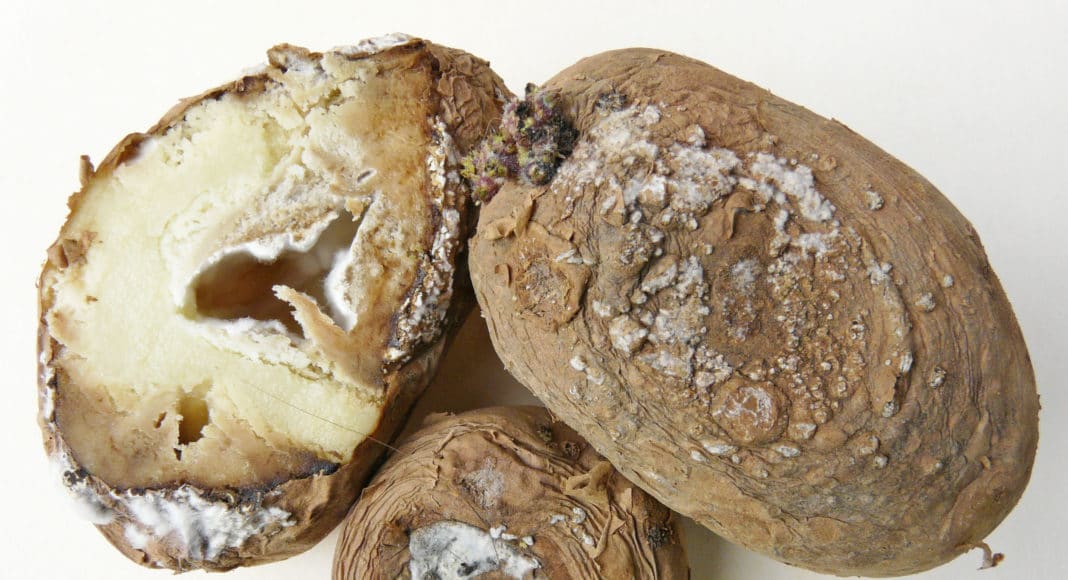There are several seed-borne diseases to check your seed for this growing season.
Several seed-borne potato diseases have the potential to reduce plant stand early in the season and cause serious economic losses. It is extremely important to examine all seed lots carefully immediately after receiving the seed.
To do this, take random samples of tubers and wash them. This will allow you to see silver scurf, black dot and superficial common scab — which are not easy to see if the tubers are unwashed. If you find diseases or defects, check the receiving tolerances set by the Canadian Food and Inspection Agency (CFIA).
Common seed-borne diseases which cause seed decay and reduce yield are:
- Fusarium dry rot (Fusarium spp) — External dry rot lesions are sunken and shriveled with concentric wrinkles. The internal rotted tissue ranges from brown or grey to black and is dry and crumbly. There is no noticeable smell. Fusarium often rots the centre of the tuber forming a cavity, and the walls of the cavity are lined with rotting tissue which may be white or yellow or pink. Fusarium spores can contaminate healthy seed during the cutting operation. There are seed-piece treatments to prevent the spread of fusarium during seed cutting, but no seed treatment can turn bad seed good.
- Late blight (Phytophthora infestans) — Look for slightly sunken, purplish areas on the tubers. A granular, reddish-brown, dry rot developing under the lesions and extending into the tuber flesh. Cutting seed will spread the disease to healthy tubers. CFIA allows seed lots with up to one per cent of late blight. Not all infected seed will rot in the ground and you could end up with about 150 infected seed pieces per acre. There are seed treatments to control late blight but expect problems if it’s a cool, wet growing season.
- Rhizoctonia black scurf (R. solani) — Rhizoctonia does not cause seed decay but infects sprouts. Black, irregularly shaped survival structures called sclerotia develop on the surface of affected tubers. Sclerotia germinate producing a fungal growth infecting sprouts and causing dark brown cankers which pinch off sprouts. New sprouts will emerge, but they will be less vigorous than the first flush of sprouts resulting in weaker plants. Infections which kill sprouts before emergence result in poor stands. Rhizoctonia development is favoured by cool, wet weather. There are seed treatments to provide protection against this disease.
- Blackleg Complex — In Ontario, some species of soft rot bacteria cause both tuber soft rot and blackleg. The disease symptoms are indistinguishable with tuber rot being wet and granular. With time, the rotting tissue darkens from cream to brown to black. There is a sharp, dark line between healthy and diseased tissue. PCR tests are required for correct identification. These are both poor soil survivors who thrive under wet conditions. The bacteria overwinter in infected seed tubers in storage. Secondary bacteria which invade infected tubers will give off a fishy smell.
- Pectobacterium atrosepticum aka “old blackleg” — Tuber decay starts at the stolon attachment where tissue becomes blackened and soft. As the disease progresses, the entire tuber may rot. It is more common on wet, cool (below 25 C) environments. Infected plants may emerge, but they die early in the season.
- Pectobacterium parmentieri — It’s more aggressive than the old blackleg, designated as a better tuber rotter and can cause severe crop losses. It favours warmer temperatures than the old blackleg.
- Dickeya dianthicola — It’s favoured by temperatures above 25 C which explains why infected tubers will remain dormant in storage.
- Another common soft rot bacterium, Pectobacterium carotovorum carotovorum causes tuber soft rot and aerial stem rot, but rarely causes blackleg. It may cause lenticel rot in high humidity storage conditions.
There are no seed treatments to control soft rots. Infected tubers need to be graded out carefully and seed cutters disinfested often to reduce the spread of the bacteria.











